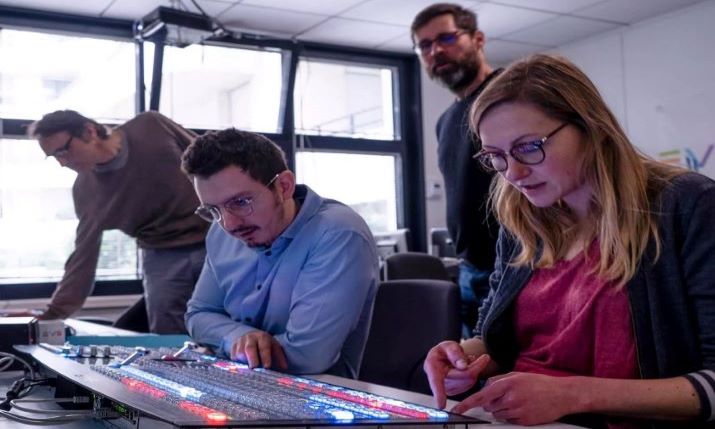Unprecedented challenge: Finding new blood to crew the sports broadcasting and production industry

Sigrid Lelièvre, multi-camera live sports director, hard at work on the Broadcast Academy’s Live Sports Direction Course
With COVID-19 having deprived audiences of live sport events for more than 18 months, the appetite for upcoming world-class events such as the FIFA World Cup or the Olympics has never been higher.
However, the broadcast industry is facing the unprecedented challenge of having to staff these events with new blood, as many members of the broadcast community have chosen new career paths during the two year hiatus.
The demand for sporting entertainment is booming but paradoxically there has also been a drain of talents in the industry, and younger professionals who are entering the market find themselves lacking guidance.
“This is where we come into play”, explained Armelle Canet, head of the Broadcast Academy. “Talking to the industry leaders, we have realised that there has been a consequential change in the past three years and there is a need to train professionals due to the turnover in the industry.”
To be successful, however, Canet believes, trainings need two things: to be accessible, and be based on a mix of theory and practice.
Regarding the former, she says it is imperative to consider that younger professionals starting their careers don’t have the same resources their more established colleagues have. Offering bursaries or financial schemes are key to make sure they can access relevant trainings. This investment from broadcasters or event organisers will in time be repaid tenfold, as the talents they take a chance on will spur new visions when producing events.
On practice, while an academic theoretical approach can be necessary, younger talents starting on their careers often do not have the opportunity to test their skills in a real life environment and therefore are not always prepared to face the specificities that come with operating in a fast-paced environment.
“For instance, young professionals might have been taught the theory of replays at school, but no academic knowledge can prepare them for the demands of working in an OB Van, where the pressure of operating live cannot be overlooked. We need to offer them practical training opportunities that can give them tips to be better equipped to face real-life situations,” said Canet.
Canet said training should not be reserved exclusively for younger generations, however. “The constant change in technologies, the recent switch to IP, new cloud-based workflows, or the integration of augmented and virtual reality make frequent training even more crucial. This is particularly relevant for certain positions, such as replay operators or commentators, where software, machines and the technical set up are often updated.
“Having skilled, trained professionals will allow the industry to embrace change, ensuring event coverage is at the forefront of innovation, producing a more engaging product for the audience. Upskilling professionals doesn’t only benefit the trainees, but ultimately adds value to the coverage of a sport competition, wherever it takes place.”
There are of course differences in coverage style (and in some cases standards,) whether operating in South America, Europe or Asia. But the nature of the industry means that it is a global, interconnected market. Ultimately best practices, or qualities that make a great replay operator or an outstanding camera operator, are the same, wherever a production crew is hailing from, noted Canet.
Oscar Sanchez, executive producer and director of broadcast operations and media distribution at Concacaf, recently wrote a piece on LinkedIn about what makes a good football director. He acknowledged that judging a director is complicated as every country has a particular style that its fans are used to. However, as he highlighted, in his experience, the best directors all exhibit the same qualities.
Among these qualities is storytelling, he said: “It is not about the number of cameras or how good you are covering a match, it is about how you tell the stories of an event. Great directors prepare themselves before getting to the venue to understand the possible storylines and find a balance between the live action and what is happening around them.”
Canet said that we should therefore not limit our considerations about training to our own geographical area. Training should be considered as a global goal, and with events happening all over the world, it is crucial – not to mention less costly and more sustainable – to be able to recruit local staff instead of flying in whole production and technical teams. Without adequate training, that simply will not be possible, she noted.
“Lastly we should also consider that cross-territory training offers a platform for professionals from different backgrounds or geographic origins to meet and exchange. It ensures no one is working in silos, and that we can all benefit from each other’s experience, which will in turn encourage agility in the industry.
“Training can serve a teaching purpose and can also be seen as a networking platform, whether digital or in-person. Circling back to the original argument about the importance of the link between seasoned pro and younger talents, training can also offer an opportunity for younger professionals to be mentored by established figures of the community, offering long lasting support and necessary assistance to kick start a career.”
Concluded Canet: “While industry hot-button topics like IP and remote workflows are generating a lot of debate, perhaps it is recruitment and training that is the most critical issue that the broadcast industry must solve. We all have a role to play, and it’s time to rise to the challenge.”

